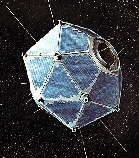|
|
Vela-5B

The Vela-5B nuclear test detection satellite was part of a program run jointly
by the Advanced Research Projects of the U.S. Department of Defense and the
U.S.Atomic Energy Commission, managed by the U.S. Air Force. It was placed in a
nearly circular orbit at a geocentric distance of ~118,000 km on 23 May 1969;
the orbital period was ~112 hours. The satellite rotated about its spin axis
with a ~64-sec period. The X-ray detector was located ~90 degrees from the spin
axis, and so covered the celestial sphere twice per satellite orbit. Data were
telemetered in 1-sec count accumulations. Vela-5B operated until 19 June 1979,
although telemetry tracking was poor after mid-1976.
While modest in its size and limited by its high background, Vela-5B's long
lifetime afforded it unique opportunities major scientific contributions.
It was one of the first satellites to report the existence of gamma-ray
bursts, and co-discovered (with ANS) X-ray bursts.
The long mission lifetime gave the opportunities to monitor the variability
in X-ray binaries and records transient behaviour.
Vela-5B carried two set of instruments : the scintillation X-ray detector (XC)
and 6 gamma ray detector.
The scintillation X-ray detector (XC) aboard Vela-5B consisted of two
1-mm-thick NaI(Tl) crystals mounted on photomultiplier tubes and covered by a
5-mil-thick beryllium window. Electronic thresholds provided two energy
channels, 3-12 keV and 6-12 keV. In front of each crystal was a slat
collimator providing a FWHM aperture of ~6.1x6.1 degrees. The effective
detector area was ~26 cm2. Sensitivity to celestial sources was severely
limited by the intrinsic detector background of ~36 cts/sec. The Vela-5B X-ray
detector yielded ~40 cts/sec for the Crab, so 1 Vela ct/sec ~25
UFU~4.5X10-10 ergs/sq-cm/sec in the 3-12 keV response band.
One important detector performance characteristic which affects the Vela-5B
data is a gain variation due to a ~60° C satellite temperature change from
one side of the orbit to the other. If the data for a source were taken when
the satellite was at one of its temperature extremes, a profound modulation is
introduced into the count rate at the 56-hour timescale between observation
sequences of the source. Additionally, the amplitude of the effect is modulated
by the ~300-day precession period of the Vela-5B orbit. Lack of pre-launch
testing precludes any quantitative post-launch compensation. A temperature
time history is available to HEASARC users in a FITS file (VELA_TEMP) so that
they may check any suspicious source data against the known times of
temperature extremes.
The time history of the Crab detected flux decreased by ~15% between 1969 and
1979. It is believed that this decrease is due to a gain change in the XC
detector as it aged. No attempt to correct for this trend has been made in the
data processing. Users who desire to do so, or who want to express detected
source intensities in units of crabs, will have to access the FITS file
containing the Crab data to extract the necessary information.
Both Vela-5A and 5B also carried 6 gamma ray detectors. They had a total
volume of ~60 cm3 of CsI and could detect photons in the 150-750 keV
energy range. It was in 1969-70 that the Vela spacecraft first discovered
gamma ray bursts. The four Vela satellites (5A & B,
6A & B) recorded 73 gamma-ray bursts in the ten year interval July 1969 -
April 1979.
[Vela-5B Home]
[About Vela-5B]
[Archive]
[Gallery]
[Publications]
Page authors: Lorella Angelini Jesse Allen
HEASARC Home |
Observatories |
Archive |
Calibration |
Software |
Tools |
Students/Teachers/Public
Last modified: Wednesday, 08-Oct-2003 19:05:56 EDT
|


